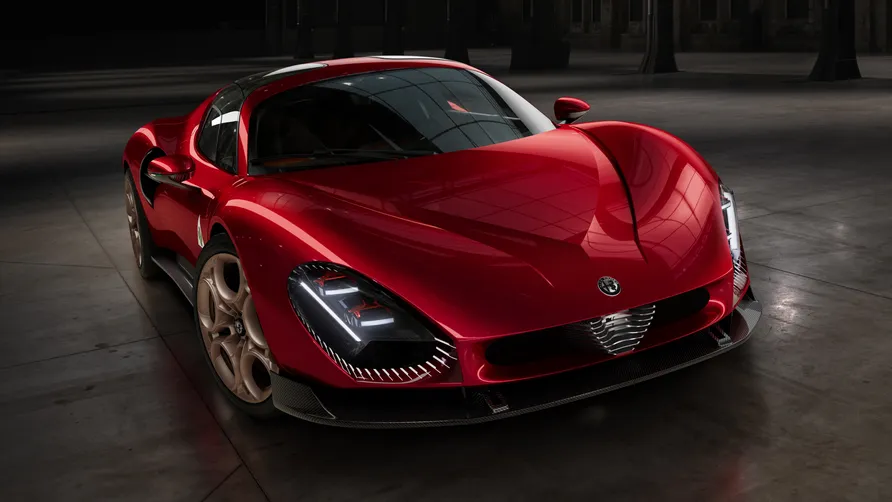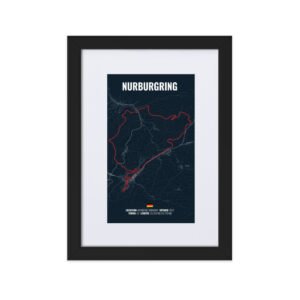

The Alfa Romeo 33 Stradale is a legendary name, first introduced in 1967 as a mid-engine sports car designed by Franco Scaglione. Known for its beauty and racing pedigree, the original was limited to 18 units and is considered one of the first true supercars. The revival, unveiled in August 2023, marks Alfa Romeo’s return to custom-built vehicles since 1969, aiming to bridge its storied past with a sustainable, electric future.

The design team, led by Alejandro Mesonero-Romanos, drew heavily from the 1967 model, focusing on elements like the butterfly doors and low-slung profile. Modern updates include LED headlamps that serve both lighting and cooling functions, and a carbon-fiber body for lightweight performance. The interior is minimalist, emphasizing driver engagement with physical switchgear and a steering wheel free of controls, echoing the original’s focus on simplicity and beauty.
The new 33 Stradale offers two powertrain options:
Both options ensure a 0-60 mph time under 3 seconds and a top speed of 207 mph, blending classic performance with modern efficiency.

Mesonero-Romanos highlighted the project as a dream for the Alfa Romeo Style Centre, emphasizing the need to respect the original’s iconic status while innovating. The collaborative “Bottega” program allowed customers to customize their cars, ensuring each of the 33 units is unique. This approach reflects the brand’s artisan heritage, balancing tradition with personalized modernity.
To engage enthusiasts, Alfa Romeo could offer limited edition merchandise like die-cast models, apparel featuring the 33 Stradale’s design, and art prints of its sketches, creating a tangible connection to this historic moment.
The revival of the Alfa Romeo 33 Stradale represents a significant milestone for the brand, merging its rich heritage with forward-looking innovation. This section delves into the detailed process, design decisions, and broader implications, providing a comprehensive overview for Alfa Romeo enthusiasts and those interested in automotive design careers.

The original Alfa Romeo 33 Stradale, launched in 1967, was a mid-engine sports car derived from the Tipo 33 racing prototype. Designed by Franco Scaglione and built by Carrozzeria Marazzi, it featured forward-opening butterfly doors and an aluminum body, with only 18 units produced between 1967 and 1969. It was the fastest car for the standing kilometer at its debut and the most expensive car in Italy at US$17,000 (equivalent to $153,700 in 2024). Its design philosophy, as shared by Scaglione’s daughter Giovanna, focused on combining aerodynamics with elegance, using methods like woollen threads to study air flows without modern wind tunnels.


Unveiled on August 30, 2023, the new 33 Stradale is Alfa Romeo’s first custom-built car since 1969, with production limited to 33 units, all sold out by early 2024. It’s a “fuoriserie” (custom-built) project, handcrafted by Carrozzeria Touring Superleggera, and designed to bridge the gap between internal combustion engines and electric mobility. The car’s development began in June 2022, initiated by Jean-Philippe Imparato, head of Alfa Romeo, and drew from an abandoned project initially intended for the Maserati MC20.
The design was led by Alejandro Mesonero-Romanos, who joined Alfa Romeo in mid-2021 after stints at Seat, Cupra, and briefly Dacia. He described the project as a dream for the Alfa Romeo Style Centre, bridging a 57-year gap to revive the 33 Stradale. The team, based at the Centro Stile in Turin, worked with a small group of designers and engineers, inspired by Renaissance workshops and Sixties coachbuilders through the “Bottega” program. This allowed customers to actively participate in customization, ensuring each car is unique, from exterior colors to interior details, with the option to personally sign the chassis number.
Mesonero-Romanos emphasized the balance between heritage and innovation:
Challenges included maintaining the original’s aesthetic purity while incorporating contemporary functionality, such as aerodynamics for high speeds and comfort for everyday use. The design process was quick, with only one styling model milled, and customer feedback at the 2022 Monza Grand Prix was crucial for validation.

The new 33 Stradale offers two powertrain options, reflecting Alfa Romeo’s commitment to both tradition and future mobility:
The car’s dimensions are 4.6 meters long, 2.1 meters wide, and 1.2 meters high, with a 2.7-meter wheelbase, ensuring a squat, lithe appearance that adds bulk to the original’s svelte lines.
Given the exclusivity of the 33 Stradale, Alfa Romeo can leverage its launch for merchandise to engage both younger audiences and established enthusiasts. Suggested items include:
These items can be marketed through the official Alfa Romeo website, enhancing brand loyalty and creating collectible value.
For readers interested in automotive design, the 33 Stradale project exemplifies the importance of heritage in shaping modern designs. The collaborative “Bottega” approach highlights the role of customer interaction in bespoke projects, offering insights into how designers balance artistic vision with commercial viability. The use of carbon-fiber and electric powertrains also underscores the need for designers to adapt to sustainability trends, making this a case study for aspiring designers.
The Alfa Romeo 33 Stradale’s revival is a masterful blend of past and future, honoring Franco Scaglione’s legacy while pushing the boundaries of modern supercar design. With its limited production and personalized approach, it not only celebrates Alfa Romeo’s history but also sets a benchmark for future innovations, engaging enthusiasts across generations.





